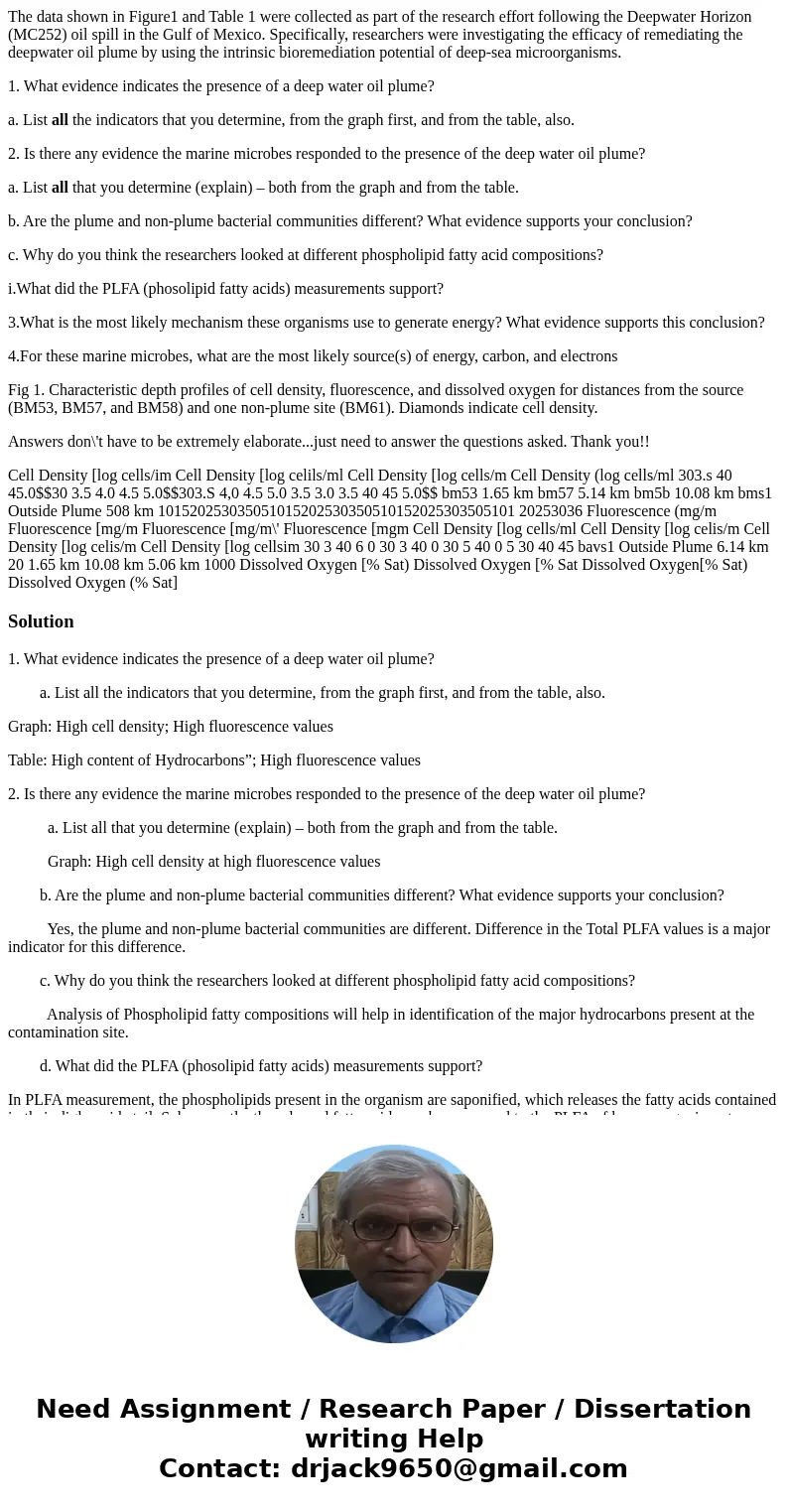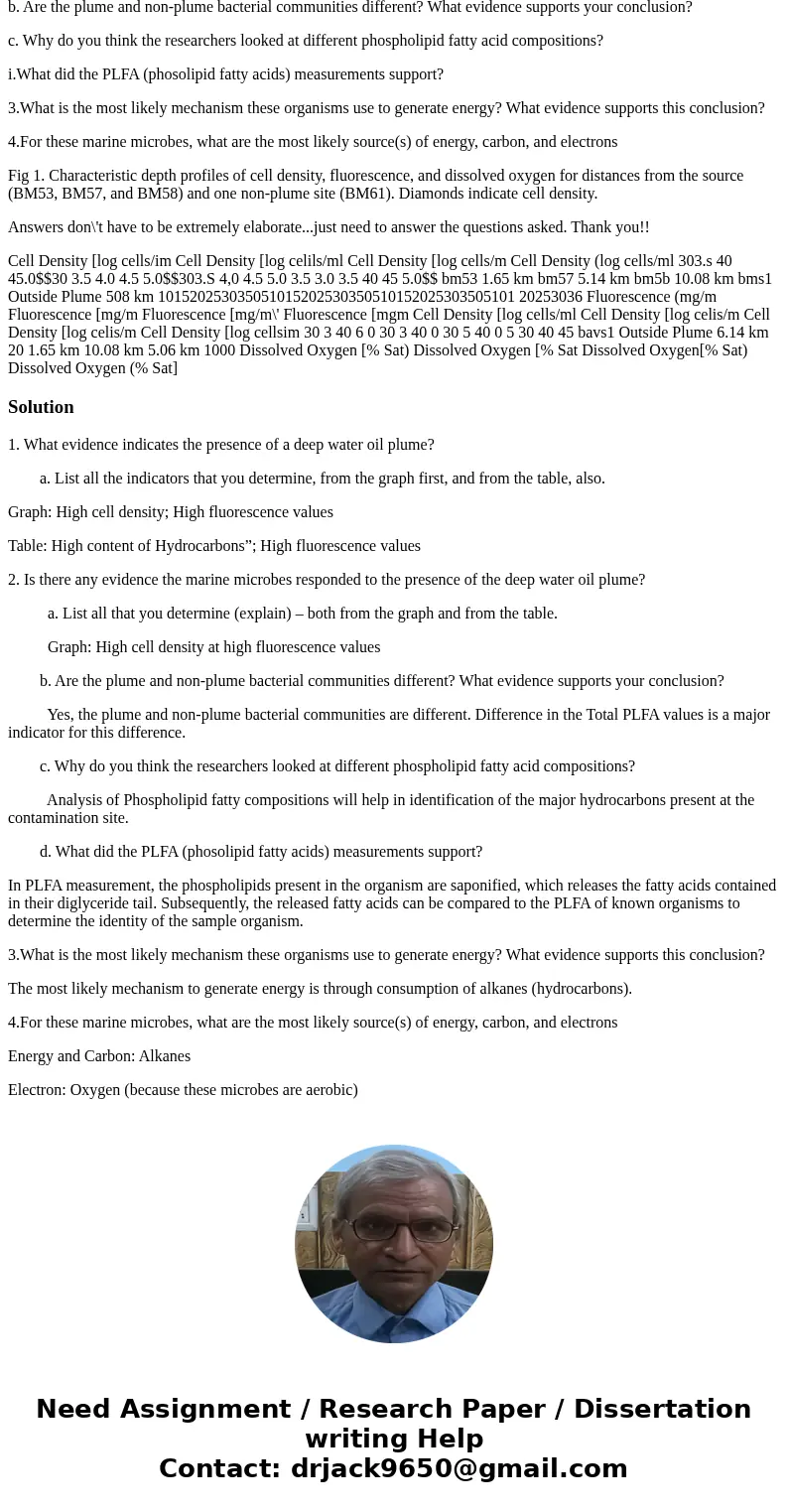The data shown in Figure1 and Table 1 were collected as part
The data shown in Figure1 and Table 1 were collected as part of the research effort following the Deepwater Horizon (MC252) oil spill in the Gulf of Mexico. Specifically, researchers were investigating the efficacy of remediating the deepwater oil plume by using the intrinsic bioremediation potential of deep-sea microorganisms.
1. What evidence indicates the presence of a deep water oil plume?
a. List all the indicators that you determine, from the graph first, and from the table, also.
2. Is there any evidence the marine microbes responded to the presence of the deep water oil plume?
a. List all that you determine (explain) – both from the graph and from the table.
b. Are the plume and non-plume bacterial communities different? What evidence supports your conclusion?
c. Why do you think the researchers looked at different phospholipid fatty acid compositions?
i.What did the PLFA (phosolipid fatty acids) measurements support?
3.What is the most likely mechanism these organisms use to generate energy? What evidence supports this conclusion?
4.For these marine microbes, what are the most likely source(s) of energy, carbon, and electrons
Fig 1. Characteristic depth profiles of cell density, fluorescence, and dissolved oxygen for distances from the source (BM53, BM57, and BM58) and one non-plume site (BM61). Diamonds indicate cell density.
Answers don\'t have to be extremely elaborate...just need to answer the questions asked. Thank you!!
Cell Density [log cells/im Cell Density [log celils/ml Cell Density [log cells/m Cell Density (log cells/ml 303.s 40 45.0$$30 3.5 4.0 4.5 5.0$$303.S 4,0 4.5 5.0 3.5 3.0 3.5 40 45 5.0$$ bm53 1.65 km bm57 5.14 km bm5b 10.08 km bms1 Outside Plume 508 km 101520253035051015202530350510152025303505101 20253036 Fluorescence (mg/m Fluorescence [mg/m Fluorescence [mg/m\' Fluorescence [mgm Cell Density [log cells/ml Cell Density [log celis/m Cell Density [log celis/m Cell Density [log cellsim 30 3 40 6 0 30 3 40 0 30 5 40 0 5 30 40 45 bavs1 Outside Plume 6.14 km 20 1.65 km 10.08 km 5.06 km 1000 Dissolved Oxygen [% Sat) Dissolved Oxygen [% Sat Dissolved Oxygen[% Sat) Dissolved Oxygen (% Sat]Solution
1. What evidence indicates the presence of a deep water oil plume?
a. List all the indicators that you determine, from the graph first, and from the table, also.
Graph: High cell density; High fluorescence values
Table: High content of Hydrocarbons”; High fluorescence values
2. Is there any evidence the marine microbes responded to the presence of the deep water oil plume?
a. List all that you determine (explain) – both from the graph and from the table.
Graph: High cell density at high fluorescence values
b. Are the plume and non-plume bacterial communities different? What evidence supports your conclusion?
Yes, the plume and non-plume bacterial communities are different. Difference in the Total PLFA values is a major indicator for this difference.
c. Why do you think the researchers looked at different phospholipid fatty acid compositions?
Analysis of Phospholipid fatty compositions will help in identification of the major hydrocarbons present at the contamination site.
d. What did the PLFA (phosolipid fatty acids) measurements support?
In PLFA measurement, the phospholipids present in the organism are saponified, which releases the fatty acids contained in their diglyceride tail. Subsequently, the released fatty acids can be compared to the PLFA of known organisms to determine the identity of the sample organism.
3.What is the most likely mechanism these organisms use to generate energy? What evidence supports this conclusion?
The most likely mechanism to generate energy is through consumption of alkanes (hydrocarbons).
4.For these marine microbes, what are the most likely source(s) of energy, carbon, and electrons
Energy and Carbon: Alkanes
Electron: Oxygen (because these microbes are aerobic)


 Homework Sourse
Homework Sourse